SKODA FABIA 2009 2.G / 5J Repair Manual
Manufacturer: SKODA, Model Year: 2009, Model line: FABIA, Model: SKODA FABIA 2009 2.G / 5JPages: 259, PDF Size: 31.99 MB
Page 61 of 259
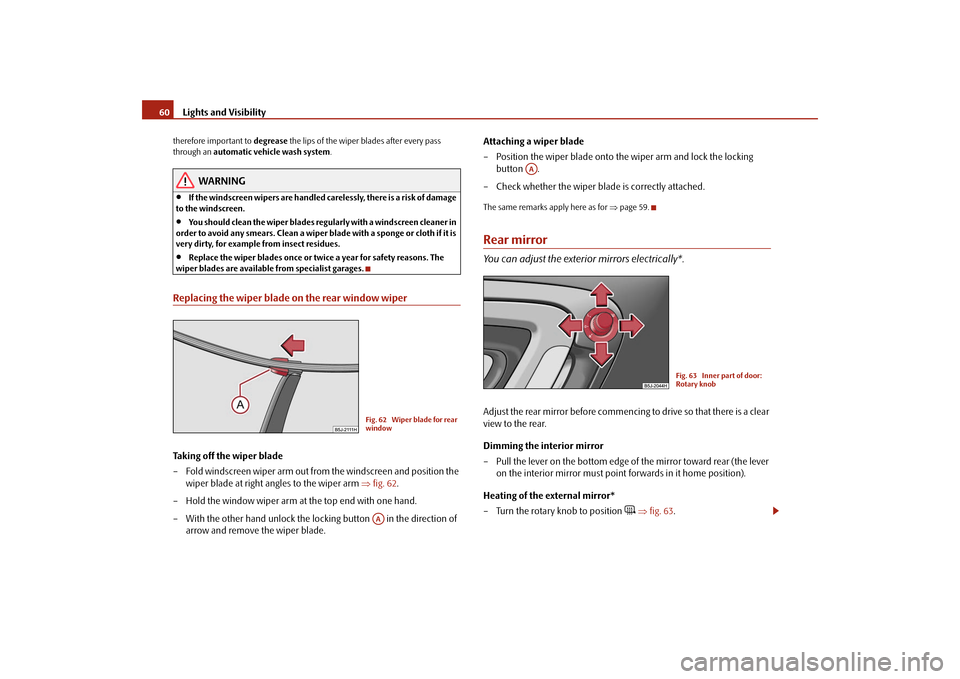
Lights and Visibility 60therefore important to degrease the lips of the wiper blades after every pass
through an automatic vehicle wash system.
WARNING
•
If the windscreen wipers are handled carelessly, there is a risk of damage
to the windscreen.
•
You should clean the wiper blades regularly with a windscreen cleaner in
order to avoid any smears. Clean a wiper blade with a sponge or cloth if it is
very dirty, for example from insect residues.
•
Replace the wiper blades once or twice a year for safety reasons. The
wiper blades are available from specialist garages.
Replacing the wiper blade on the rear window wiperTaking off the wiper blade
– Fold windscreen wiper arm out from the windscreen and position the
wiper blade at right angles to the wiper arm ⇒fig. 62.
– Hold the window wiper arm at the top end with one hand.
– With the other hand unlock the locking button in the direction of
arrow and remove the wiper blade.Attaching a wiper blade
– Position the wiper blade onto the wiper arm and lock the locking
button .
– Check whether the wiper blade is correctly attached.
The same remarks apply here as for ⇒page 59.Rear mirrorYou can adjust the exterior mirrors electrically*.Adjust the rear mirror before commencing to drive so that there is a clear
view to the rear.
Dimming the interior mirror
– Pull the lever on the bottom edge of the mirror toward rear (the lever
on the interior mirror must point forwards in it home position).
Heating of the external mirror*
– Turn the rotary knob to position
⇒fig. 63.
Fig. 62 Wiper blade for rear
windowAA
AA
Fig. 63 Inner part of door:
Rotary knob
s3f4.1.book Page 60 Thursday, June 18, 2009 11:07 AM
Page 62 of 259
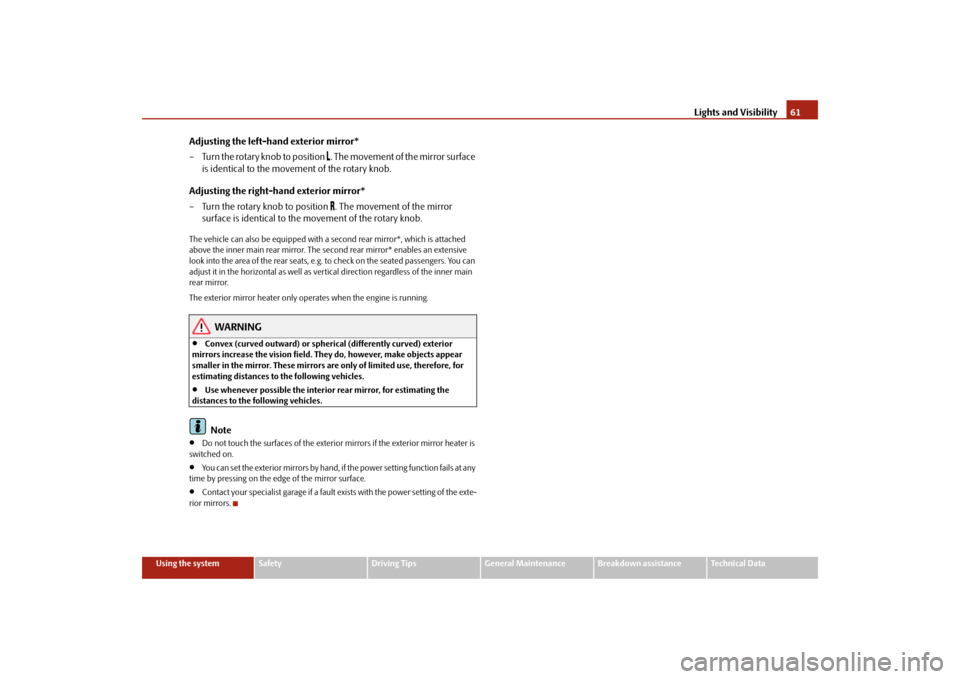
Lights and Visibility61
Using the system
Safety
Driving Tips
General Maintenance
Breakdown assistance
Technical Data
Adjusting the left-hand exterior mirror*
– Turn the rotary knob to position
. The movement of the mirror surface
is identical to the movement of the rotary knob.
Adjusting the right-hand exterior mirror*
– Turn the rotary knob to position . The movement of the mirror
surface is identical to the movement of the rotary knob.
The vehicle can also be equipped with a second rear mirror*, which is attached
above the inner main rear mirror. The second rear mirror* enables an extensive
look into the area of the rear seats, e.g. to check on the seated passengers. You can
adjust it in the horizontal as well as vertical direction regardless of the inner main
rear mirror.
The exterior mirror heater only operates when the engine is running.
WARNING
•
Convex (curved outward) or spherical (differently curved) exterior
mirrors increase the vision field. They do, however, make objects appear
smaller in the mirror. These mirrors are only of limited use, therefore, for
estimating distances to the following vehicles.
•
Use whenever possible the interior rear mirror, for estimating the
distances to the following vehicles.Note
•
Do not touch the surfaces of the exterior mirrors if the exterior mirror heater is
switched on.
•
You can set the exterior mirrors by hand, if the power setting function fails at any
time by pressing on the edge of the mirror surface.
•
Contact your specialist garage if a fault exists with the power setting of the exte-
rior mirrors.
s3f4.1.book Page 61 Thursday, June 18, 2009 11:07 AM
Page 63 of 259
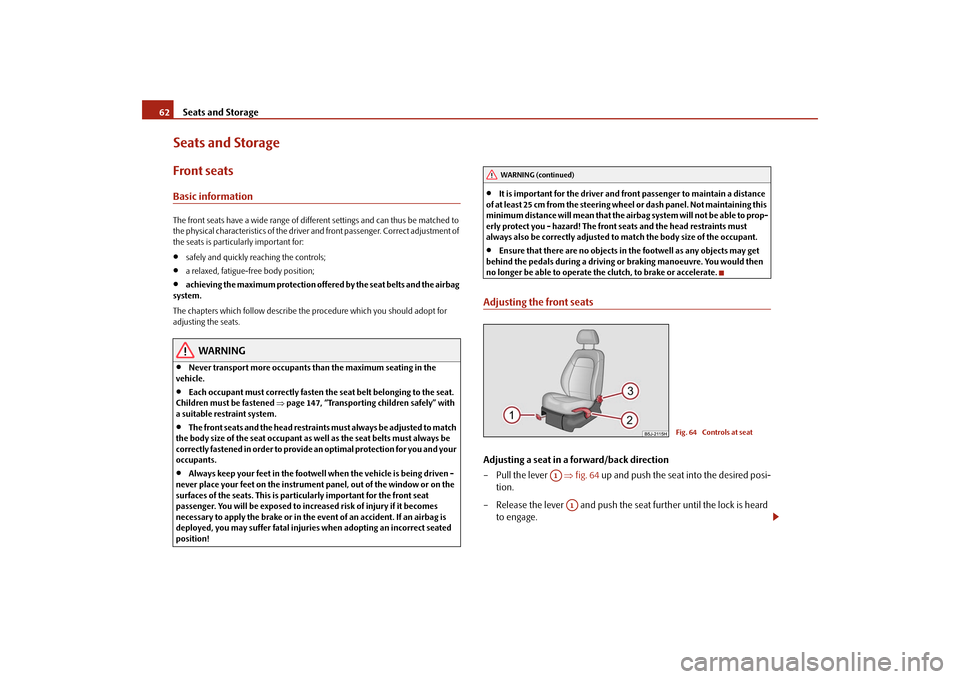
Seats and Storage 62Seats and StorageFront seatsBasic informationThe front seats have a wide range of different settings and can thus be matched to
the physical characteristics of the driver and front passenger. Correct adjustment of
the seats is particularly important for:•
safely and quickly reaching the controls;
•
a relaxed, fatigue-free body position;
•
achieving the maximum protection offered by the seat belts and the airbag
system.
The chapters which follow describe the procedure which you should adopt for
adjusting the seats.
WARNING
•
Never transport more occupants than the maximum seating in the
vehicle.
•
Each occupant must correctly fasten the seat belt belonging to the seat.
Children must be fastened ⇒page 147, “Transporting children safely” with
a suitable restraint system.
•
The front seats and the head restraints must always be adjusted to match
the body size of the seat occupant as well as the seat belts must always be
correctly fastened in order to provide an optimal protection for you and your
occupants.
•
Always keep your feet in the footwell when the vehicle is being driven -
never place your feet on the instrument panel, out of the window or on the
surfaces of the seats. This is particularly important for the front seat
passenger. You will be exposed to increased risk of injury if it becomes
necessary to apply the brake or in the event of an accident. If an airbag is
deployed, you may suffer fatal injuries when adopting an incorrect seated
position!
•
It is important for the driver and front passenger to maintain a distance
of at least 25 cm from the steering wheel or dash panel. Not maintaining this
minimum distance will mean that the airbag system will not be able to prop-
erly protect you - hazard! The front seats and the head restraints must
always also be correctly adjusted to match the body size of the occupant.
•
Ensure that there are no objects in the footwell as any objects may get
behind the pedals during a driving or braking manoeuvre. You would then
no longer be able to operate the clutch, to brake or accelerate.
Adjusting the front seatsAdjusting a seat in a forward/back direction
– Pull the lever ⇒fig. 64 up and push the seat into the desired posi-
tion.
– Release the lever and push the seat further until the lock is heard
to engage.
WARNING (continued)
Fig. 64 Controls at seat
A1
A1
s3f4.1.book Page 62 Thursday, June 18, 2009 11:07 AM
Page 64 of 259
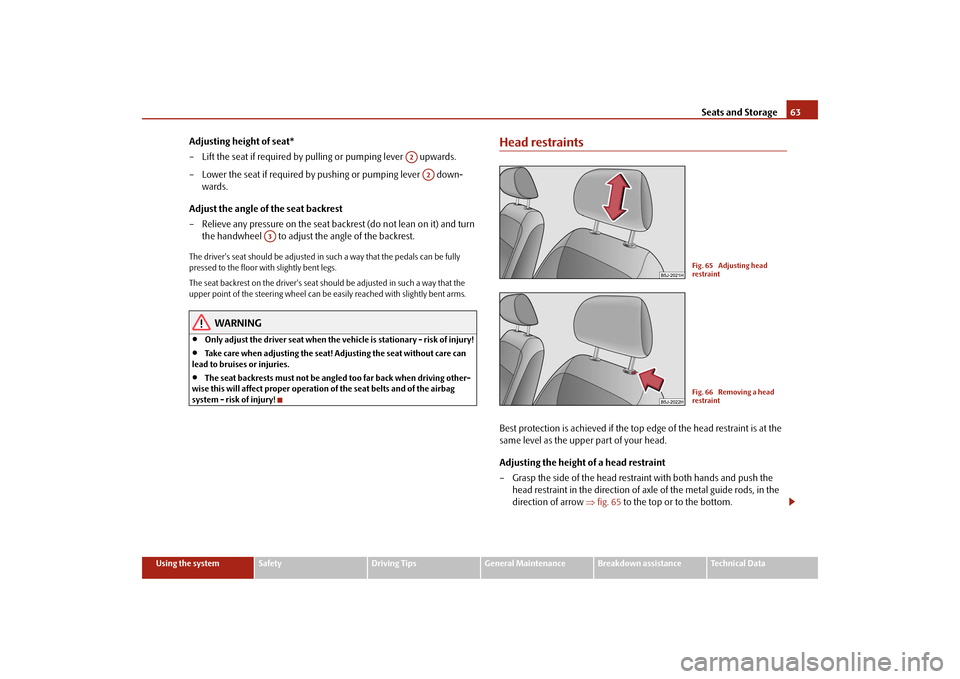
Seats and Storage63
Using the system
Safety
Driving Tips
General Maintenance
Breakdown assistance
Technical Data
Adjusting height of seat*
– Lift the seat if required by pulling or pumping lever upwards.
– Lower the seat if required by pushing or pumping lever down-
wards.
Adjust the angle of the seat backrest
– Relieve any pressure on the seat backrest (do not lean on it) and turn
the handwheel to adjust the angle of the backrest.The driver's seat should be adjusted in such a way that the pedals can be fully
pressed to the floor with slightly bent legs.
The seat backrest on the driver's seat should be adjusted in such a way that the
upper point of the steering wheel can be easily reached with slightly bent arms.
WARNING
•
Only adjust the driver seat when the vehicle is stationary - risk of injury!
•
Take care when adjusting the seat! Adjusting the seat without care can
lead to bruises or injuries.
•
The seat backrests must not be angled too far back when driving other-
wise this will affect proper operation of the seat belts and of the airbag
system - risk of injury!
Head restraintsBest protection is achieved if the top edge of the head restraint is at the
same level as the upper part of your head.
Adjusting the height of a head restraint
– Grasp the side of the head restraint with both hands and push the
head restraint in the direction of axle of the metal guide rods, in the
direction of arrow ⇒fig. 65 to the top or to the bottom.
A2
A2
A3
Fig. 65 Adjusting head
restraintFig. 66 Removing a head
restraint
s3f4.1.book Page 63 Thursday, June 18, 2009 11:07 AM
Page 65 of 259
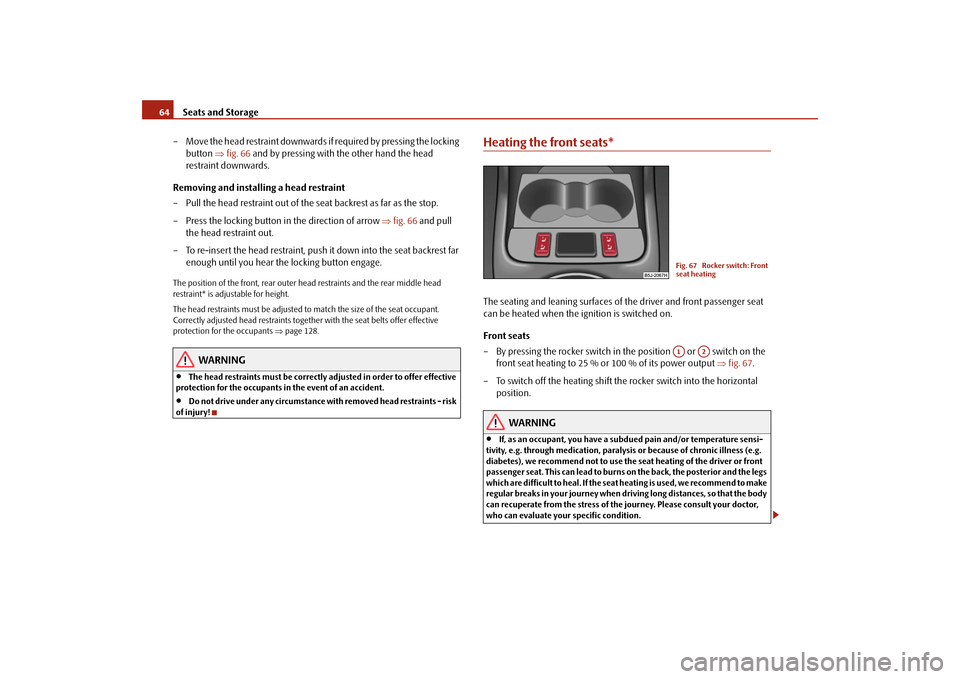
Seats and Storage 64
– Move the head restraint downwards if required by pressing the locking
button ⇒fig. 66 and by pressing with the other hand the head
restraint downwards.
Removing and installing a head restraint
– Pull the head restraint out of the seat backrest as far as the stop.
– Press the locking button in the direction of arrow ⇒fig. 66 and pull
the head restraint out.
– To re-insert the head restraint, push it down into the seat backrest far
enough until you hear the locking button engage.The position of the front, rear outer head restraints and the rear middle head
restraint* is adjustable for height.
The head restraints must be adjusted to match the size of the seat occupant.
Correctly adjusted head restraints together with the seat belts offer effective
protection for the occupants ⇒page 128.
WARNING
•
The head restraints must be correctly adjusted in order to offer effective
protection for the occupants in the event of an accident.
•
Do not drive under any circumstance with removed head restraints - risk
of injury!
Heating the front seats*The seating and leaning surfaces of the driver and front passenger seat
can be heated when the ignition is switched on.
Front seats
– By pressing the rocker switch in the position or switch on the
front seat heating to 25 % or 100 % of its power output ⇒fig. 67.
– To switch off the heating shift the rocker switch into the horizontal
position.
WARNING
•
If, as an occupant, you have a subdued pain and/or temperature sensi-
tivity, e.g. through medication, paralysis or because of chronic illness (e.g.
diabetes), we recommend not to use the seat heating of the driver or front
passenger seat. This can lead to burns on the back, the posterior and the legs
which are difficult to heal. If the seat heating is used, we recommend to make
regular breaks in your journey when driving long distances, so that the body
can recuperate from the stress of the journey. Please consult your doctor,
who can evaluate your specific condition.
Fig. 67 Rocker switch: Front
seat heatingA1
A2
s3f4.1.book Page 64 Thursday, June 18, 2009 11:07 AM
Page 66 of 259
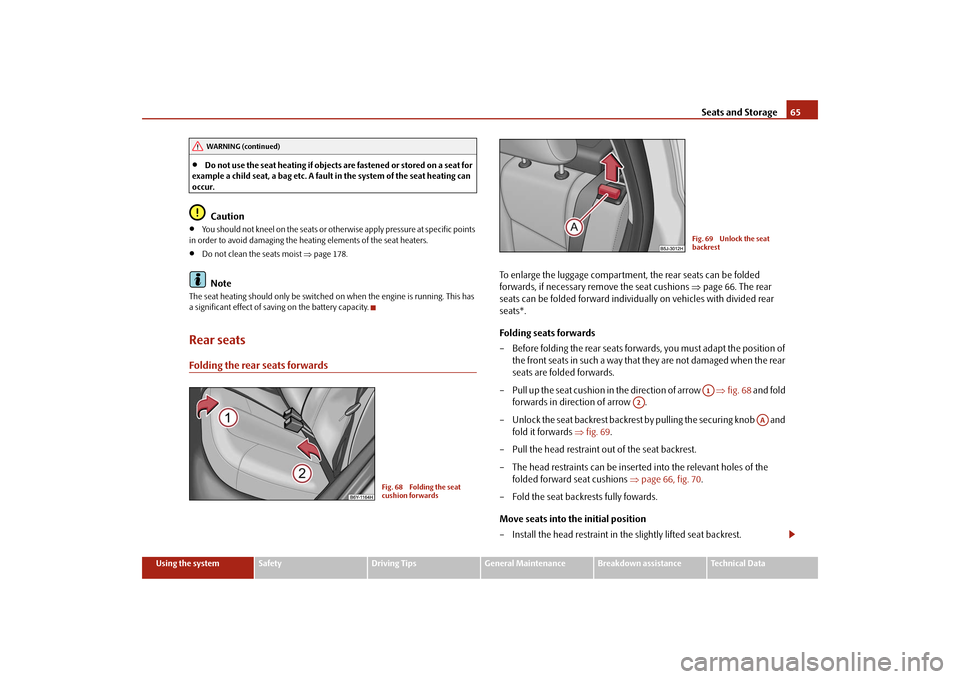
Seats and Storage65
Using the system
Safety
Driving Tips
General Maintenance
Breakdown assistance
Technical Data
•
Do not use the seat heating if objects are fastened or stored on a seat for
example a child seat, a bag etc. A fault in the system of the seat heating can
occur.Caution
•
You should not kneel on the seats or otherwise apply pressure at specific points
in order to avoid damaging the heating elements of the seat heaters.
•
Do not clean the seats moist ⇒page 178.Note
The seat heating should only be switched on when the engine is running. This has
a significant effect of saving on the battery capacity.Rear seatsFolding the rear seats forwards
To enlarge the luggage compartment, the rear seats can be folded
forwards, if necessary remove the seat cushions ⇒page 66. The rear
seats can be folded forward individually on vehicles with divided rear
seats*.
Folding seats forwards
– Before folding the rear seats forwards, you must adapt the position of
the front seats in such a way that they are not damaged when the rear
seats are folded forwards.
– Pull up the seat cushion in the direction of arrow ⇒fig. 68 and fold
forwards in direction of arrow .
– Unlock the seat backrest backrest by pulling the securing knob and
fold it forwards ⇒fig. 69.
– Pull the head restraint out of the seat backrest.
– The head restraints can be inserted into the relevant holes of the
folded forward seat cushions ⇒page 66, fig. 70.
– Fold the seat backrests fully fowards.
Move seats into the initial position
– Install the head restraint in the slightly lifted seat backrest.
WARNING (continued)
Fig. 68 Folding the seat
cushion forwards
Fig. 69 Unlock the seat
backrestA1
A2
AA
s3f4.1.book Page 65 Thursday, June 18, 2009 11:07 AM
Page 67 of 259
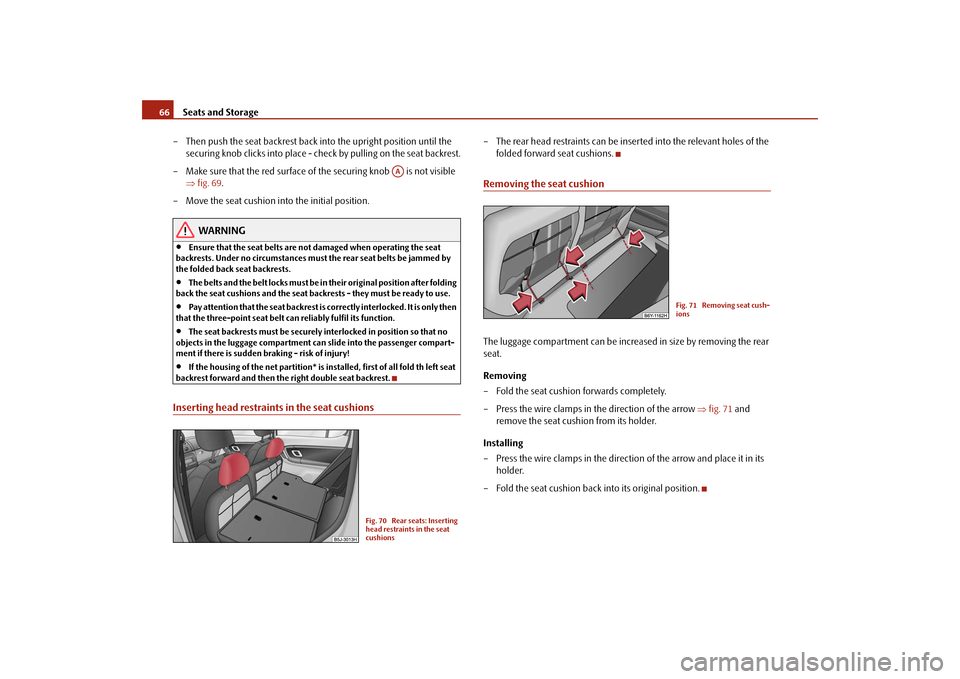
Seats and Storage 66
– Then push the seat backrest back into the upright position until the
securing knob clicks into place - check by pulling on the seat backrest.
– Make sure that the red surface of the securing knob is not visible
⇒fig. 69.
– Move the seat cushion into the initial position.
WARNING
•
Ensure that the seat belts are not damaged when operating the seat
backrests. Under no circumstances must the rear seat belts be jammed by
the folded back seat backrests.
•
The belts and the belt locks must be in their original position after folding
back the seat cushions and the seat backrests - they must be ready to use.
•
Pay attention that the seat backrest is correctly interlocked. It is only then
that the three-point seat belt can reliably fulfil its function.
•
The seat backrests must be securely interlocked in position so that no
objects in the luggage compartment can slide into the passenger compart-
ment if there is sudden braking - risk of injury!
•
If the housing of the net partition* is installed, first of all fold th left seat
backrest forward and then the right double seat backrest.
Inserting head restraints in the seat cushions
– The rear head restraints can be inserted into the relevant holes of the
folded forward seat cushions.Removing the seat cushionThe luggage compartment can be increased in size by removing the rear
seat.
Removing
– Fold the seat cushion forwards completely.
– Press the wire clamps in the direction of the arrow ⇒fig. 71 and
remove the seat cushion from its holder.
Installing
– Press the wire clamps in the direction of the arrow and place it in its
holder.
– Fold the seat cushion back into its original position.
AA
Fig. 70 Rear seats: Inserting
head restraints in the seat
cushions
Fig. 71 Removing seat cush-
ions
s3f4.1.book Page 66 Thursday, June 18, 2009 11:07 AM
Page 68 of 259
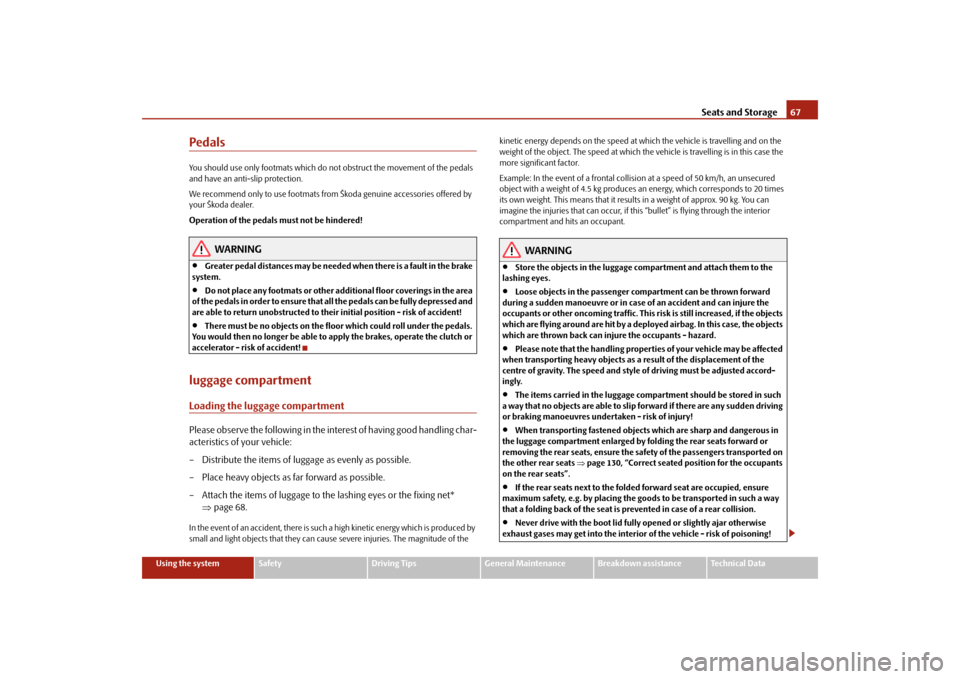
Seats and Storage67
Using the system
Safety
Driving Tips
General Maintenance
Breakdown assistance
Technical Data
PedalsYou should use only footmats which do not obstruct the movement of the pedals
and have an anti-slip protection.
We recommend only to use footmats from Škoda genuine accessories offered by
your Škoda dealer.
Operation of the pedals must not be hindered!
WARNING
•
Greater pedal distances may be needed when there is a fault in the brake
system.
•
Do not place any footmats or other additional floor coverings in the area
of the pedals in order to ensure that all the pedals can be fully depressed and
are able to return unobstructed to their initial position - risk of accident!
•
There must be no objects on the floor which could roll under the pedals.
You would then no longer be able to apply the brakes, operate the clutch or
accelerator - risk of accident!
luggage compartmentLoading the luggage compartmentPlease observe the following in the interest of having good handling char-
acteristics of your vehicle:
– Distribute the items of luggage as evenly as possible.
– Place heavy objects as far forward as possible.
– Attach the items of luggage to the lashing eyes or the fixing net*
⇒page 68.In the event of an accident, there is such a high kinetic energy which is produced by
small and light objects that they can cause severe injuries. The magnitude of the kinetic energy depends on the speed at which the vehicle is travelling and on the
weight of the object. The speed at which the vehicle is travelling is in this case the
more significant factor.
Example: In the event of a frontal collision at a speed of 50 km/h, an unsecured
object with a weight of 4.5 kg produces an energy, which corresponds to 20 times
its own weight. This means that it results in a weight of approx. 90 kg. You can
imagine the injuries that can occur, if this “bullet” is flying through the interior
compartment and hits an occupant.
WARNING
•
Store the objects in the luggage compartment and attach them to the
lashing eyes.
•
Loose objects in the passenger compartment can be thrown forward
during a sudden manoeuvre or in case of an accident and can injure the
occupants or other oncoming traffic. This risk is still increased, if the objects
which are flying around are hit by a deployed airbag. In this case, the objects
which are thrown back can injure the occupants - hazard.
•
Please note that the handling properties of your vehicle may be affected
when transporting heavy objects as a result of the displacement of the
centre of gravity. The speed and style of driving must be adjusted accord-
ingly.
•
The items carried in the luggage compartment should be stored in such
a way that no objects are able to slip forward if there are any sudden driving
or braking manoeuvres undertaken - risk of injury!
•
When transporting fastened objects which are sharp and dangerous in
the luggage compartment enlarged by folding the rear seats forward or
removing the rear seats, ensure the safety of the passengers transported on
the other rear seats ⇒page 130, “Correct seated position for the occupants
on the rear seats”.
•
If the rear seats next to the folded forward seat are occupied, ensure
maximum safety, e.g. by placing the goods to be transported in such a way
that a folding back of the seat is prevented in case of a rear collision.
•
Never drive with the boot lid fully opened or slightly ajar otherwise
exhaust gases may get into the interior of the vehicle - risk of poisoning!
s3f4.1.book Page 67 Thursday, June 18, 2009 11:07 AM
Page 69 of 259
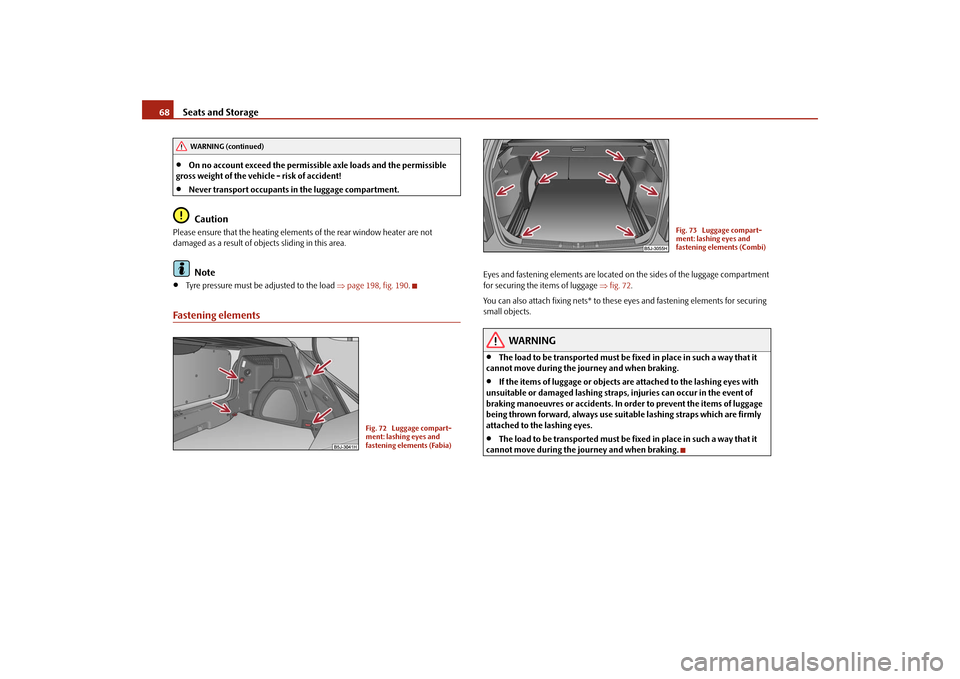
Seats and Storage 68•
On no account exceed the permissible axle loads and the permissible
gross weight of the vehicle - risk of accident!
•
Never transport occupants in the luggage compartment.Caution
Please ensure that the heating elements of the rear window heater are not
damaged as a result of objects sliding in this area.
Note
•
Tyre pressure must be adjusted to the load ⇒page 198, fig. 190.
Fastening elements
Eyes and fastening elements are located on the sides of the luggage compartment
for securing the items of luggage ⇒fig. 72.
You can also attach fixing nets* to these eyes and fastening elements for securing
small objects.
WARNING
•
The load to be transported must be fixed in place in such a way that it
cannot move during the journey and when braking.
•
If the items of luggage or objects are attached to the lashing eyes with
unsuitable or damaged lashing straps, injuries can occur in the event of
braking manoeuvres or accidents. In order to prevent the items of luggage
being thrown forward, always use suitable lashing straps which are firmly
attached to the lashing eyes.
•
The load to be transported must be fixed in place in such a way that it
cannot move during the journey and when braking.
WARNING (continued)
Fig. 72 Luggage compart-
ment: lashing eyes and
fastening elements (Fabia)
Fig. 73 Luggage compart-
ment: lashing eyes and
fastening elements (Combi)
s3f4.1.book Page 68 Thursday, June 18, 2009 11:07 AM
Page 70 of 259
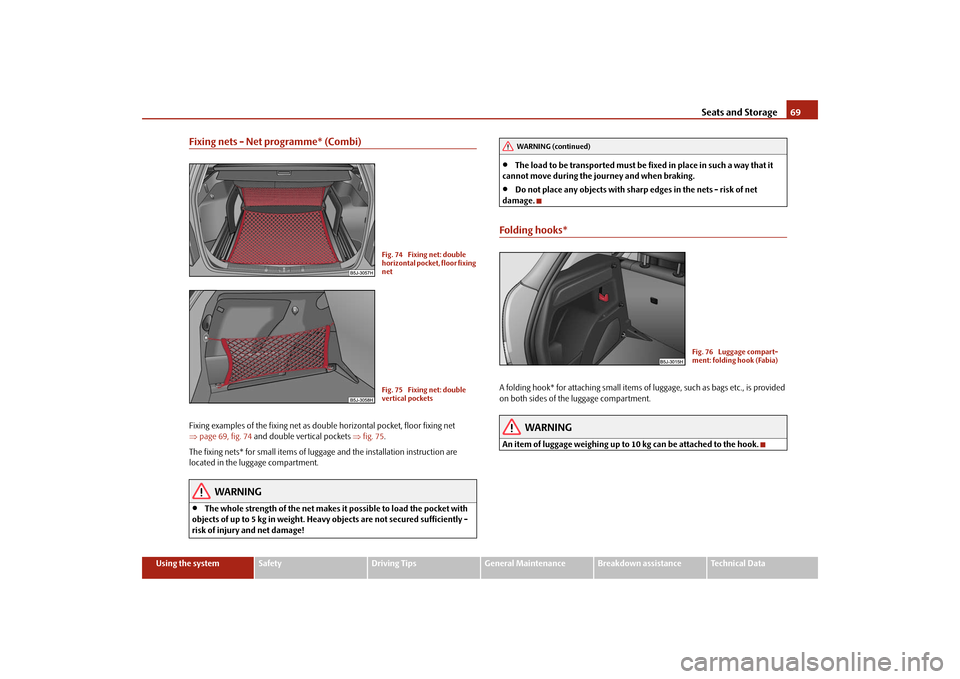
Seats and Storage69
Using the system
Safety
Driving Tips
General Maintenance
Breakdown assistance
Technical Data
Fixing nets - Net programme* (Combi)Fixing examples of the fixing net as double horizontal pocket, floor fixing net
⇒page 69, fig. 74 and double vertical pockets ⇒fig. 75.
The fixing nets* for small items of luggage and the installation instruction are
located in the luggage compartment.
WARNING
•
The whole strength of the net makes it possible to load the pocket with
objects of up to 5 kg in weight. Heavy objects are not secured sufficiently -
risk of injury and net damage!
•
The load to be transported must be fixed in place in such a way that it
cannot move during the journey and when braking.
•
Do not place any objects with sharp edges in the nets - risk of net
damage.
Folding hooks*A folding hook* for attaching small items of luggage, such as bags etc., is provided
on both sides of the luggage compartment.
WARNING
An item of luggage weighing up to 10 kg can be attached to the hook.
Fig. 74 Fixing net: double
horizontal pocket, floor fixing
netFig. 75 Fixing net: double
vertical pockets
WARNING (continued)
Fig. 76 Luggage compart-
ment: folding hook (Fabia)
s3f4.1.book Page 69 Thursday, June 18, 2009 11:07 AM